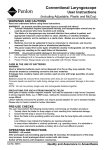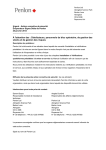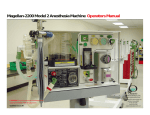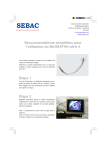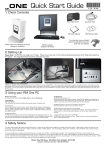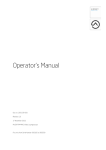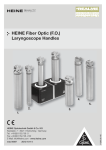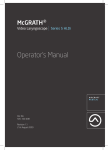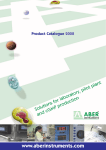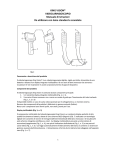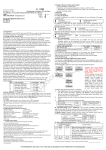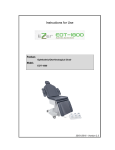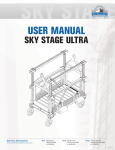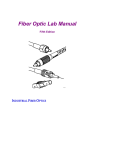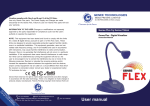Download User Manual View Document
Transcript
Diamond Range Fibrelight Laryngoscope (Including Diamond Range McCoy) User Instructions INTRODUCTION Penlon Diamond range blades and handles are compatible with other blades and handles that conform to ISO Green System requirements (ISO 7376/3). WARNINGS AND CAUTIONS Read and understand before using these instructions. WARNINGS (to prevent possible personal injury to yourself and others) 1. Tracheal intubation requires specialised training and laryngoscopes should only be used by personnel who have received such training. 2. The blade of a laryngoscope may transmit infection from patient to patient, and appropriate measures must be taken to clean, disinfect, or sterilise blades between patients, and to maintain a sterile state. Blades are not sterile when supplied new. 3. Batteries must not be subjected to heat or immersion in chemicals and must be removed from handles prior to disinfection/sterilisation. 4. The power output from some types of cells (mainly rechargeable types) can decrease quickly during use, resulting in the rapid failure of illumination. CAUTIONS (to prevent possible damage to the instrument or other property) 1. USA/Canadian Federal Law restricts this device to sale by or on the order of the physician. 2. Crystal Blade - refer to separate user instruction leaflet supplied with the blade. CARE IN THE USE OF BATTERIES WARNING Used or defective batteries must not be disposed of in fire, as they may explode. They should be treated as containing corrosive and toxic materials. If leakage from a battery makes skin contact, wash at once with large quantities of water. CAUTION Batteries should be removed from instruments when they are not required for use. Corrosive liquids can leak from cells during storage and cause permanent damage to the instrument. NOTE. Do not mix primary (single use) and rechargeable batteries. PRECAUTIONS FOR USE IN STRONG MAGNETIC FIELDS Most types of battery contain magnetic material and may be subjected to high forces if exposed to strong magnetic fields, e.g. in NMR areas, making the necessary precise control of the laryngoscope difficult. Lithium batteries overcome the problem, but require special adaption for use in standard handles. Please refer to Penlon Limited for further information. PRE-USE CHECKS The user must perform the following checks before commencing an intubation procedure. 1. Visually check the blade for sharp edges or burrs resulting from mechanical damage. 2. Move the blade to the operating position and check that the lamp lights with normal brilliance. Low brilliance may indicate that batteries are nearing exhaustion. In areas where intubation is routinely performed, e.g. operating rooms, it is advisable to have spare instruments available as battery life is short and difficult to predict. Cat No. 52758 Quality and Assurance in Anaesthesia OPERATING INSTRUCTIONS Storage Remove the batteries during storage. Decomposition products from leaking batteries can be corrosive. Fitting the blade The blade is attached to the handle in the customary 'hook-on' manner. To switch on The Laryngoscope lamp will switch on automatically when the blade is moved up to the 'locked on' operating position. To switch off Move the blade from the operating position. Using the McCoy Blade WARNING Do not grip the lever when removing the blade. Do not apply any pressure, in the directions shown in the illustration, which could force the blade and lever apart. Damage to the linkage may occur, resulting in incorrect action, or stiffness of the adjustable tip. The McCoy blade is assembled to the handle in the normal manner. The lever to operate the tip section will then extend behind the handle. The lever should not be touched during the initial stage of use, until the tip of the laryngoscope has been inserted into the vallecula. Once this stage has been reached, movement of the lever towards the handle will elevate the tip of the blade, and therefore lift the epiglottis, without the need to increase the force exerted by the main part of the blade. Release the lever before withdrawing the blade. Battery change Unscrew the handle end cap, remove batteries. Fit new batteries, see chart. Check configuration and polarity as illustrated. Handle Standard Penlight & Stubby Battery (2 per handle) LR (U11 or C) LR6 (MN1500 or AA) Standard and Penlight ROUTINE CARE AND MAINTENANCE Bulb unit replacement The bulb unit is a special design and only Penlon spares are suitable. Use Penlon bulb, Part No. 50542 (pack of 5) Clean hands before handling the bulb 1. 2. 3. 4. 5. Remove the batteries and push the bulb capsule (1) out through the base of the handle. Undo the green shroud (2) and unscrew the bulb (3). Fit a new bulb, refit the shroud (2), and reinsert the capsule through handle. Note - Stubby handle As illustrated, the stubby handle has a different type of capsule with an offset battery contact (4). The second battery contact (5) remains inside the handle. Check that the capsule is inserted correctly, as illustrated. Both contacts must be visible inside the handle. Replace batteries and test. With the blade in the 'locked on' operating position, the bulb should be lit. 2 3 1 Stubby 5 4 2 3 1 4 Descriptions and Markings Stainless steel blades are marked on the heel of the hook-on block to identify the type of blade and its size, the light guides are similarly identified as follows; Macintosh Robertshaw MAC RSHAW Miller Seward MIL SEW The size is indicated by numbers from 0 (smallest blade) to 4 (largest blade). CLEANING, DISINFECTION, AND STERILISATION Always comply with local health and safety regulations during these operations. When using disinfectant or sterilising solutions, the manufacturer’s recommended concentrations and time periods must be observed. 1. Handles - Cleaning and Disinfection WARNING Handle - before cleaning and disinfection, remove the base, batteries, and bulb capsule from the handle. Do not autoclave the handle assembly - see 'Sterilisation' below. 1. Remove the batteries and capsule (see previous page). 2. Scrub the handle externally, using a suitable detergent. 3. Immerse in a suitable disinfectant - follow the disinfectant manufacturer's instructions. 4. Check that the handle is dry, inside and outside, before refitting the bulb capsule and batteries, fit a blade to the handle and then test the laryngoscope before clinical use. 2. Blades - Cleaning and Disinfection CAUTIONS 1. Crystal Blade - refer to separate user instruction leaflet supplied with the blade. 2. The rigid fibre bundle light guide assembly (1) must not be bent. This will damage many of the fibres and result in a reduction of light transmission. 1. 2. 3. Remove the screw (2) and detach the light guide assembly from the blade. Scrub the components after use, preferably under running water. Rinse thoroughly. Do not use abrasive materials, such as wire wool. Clean the components again with a disinfectant solution. McCoy To remove the light guide, first remove screw A, to allow removal of lever B. The McCoy blade levering mechanism may require articulation, before the light guide can be detached from the blade. Removal of the light guide is described above. 1 2 B A 3. Handle and Blades - Sterilisation WARNINGS 1. Handle - Before sterilisation/ autoclaving - remove the base, batteries, and bulb capsule from the handle, as illustrated in the previous pages. 2. Blade / light guide - Disassemble before autoclaving McCoy - see previous page Crystal Blade - DO NOT autoclave or use Gamma irradiation - refer to separate user instructions, supplied with the blade. 3. Note - after extensive autoclaving, light output from the fibre bundle may be reduced - see 'Blades, polishing and refit' below. We recommend either, A) The use of a peracetic acid solution ( e.g. NuCidex solution ), Soak the components in peracetic acid solution. Follow the manufacturer's recommendations for solution concentration, and for soak time period. CAUTION: Do not exceed the manufacturer's recommendations. or B) The use of an autoclave. Autoclave at 134 - 137°C CAUTION Comply with nationally recommended time periods for autoclaving Blades - polishing and refit 1. After cleaning and sterilising, the faces of the fibre bundle must be polished with a dry soft cloth before attaching to the blade. 2. Note that after many sterilisations the light output of the fibre bundle may decrease. Contact Customer Service Department for details of of our re-polishing service. 3. Refit to the blade, and secure with the screw. 4. Fit the blade to the handle and test, before use. 4. The use of Washing Machines 1. 2. 3. 5. Always follow the washing machine manufacturer's instructions with regard to the machine's suitability for use on fibre-optic components. Some manufacturer's have special programmes for fibre-optic components. If the user instructions supplied with the machine do not refer to fibre-optic instruments, contact the washing machine manufacturer before washing laryngoscope fibre-optic bundles. Do not use a wash temperature greater than 60°C. Do not use hard water for the rinse cycle, and do not rinse at a temperature greater than 60°C. NOTE Some washing machine manufacturer's recommend alkaline cleaning at a low temperature, thermal disinfection, then a final rinse with fully deionised water. Thermal disinfection and drying phases must be at a minimum temperature of 85°C and hold time in compliance with local/ national regulations. Cat No 52758 Doc No FL(G)0200UI August 2000 Penlon Limited Radley Road, Abingdon OX14 3PH UK Service Tel:+44 (0) 1235 547063 E-mail: [email protected] Fax: +44 (0) 1235 547062




